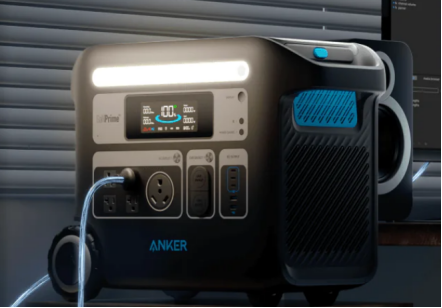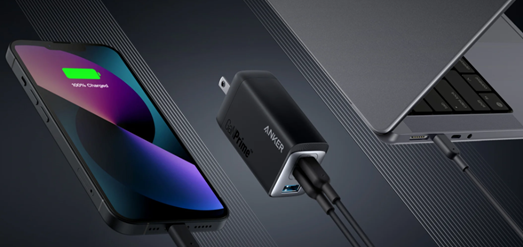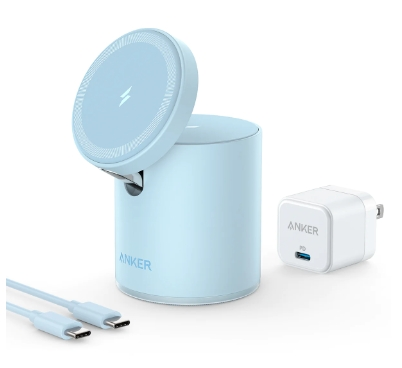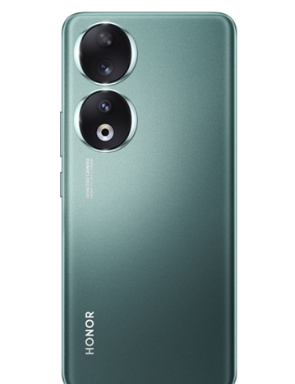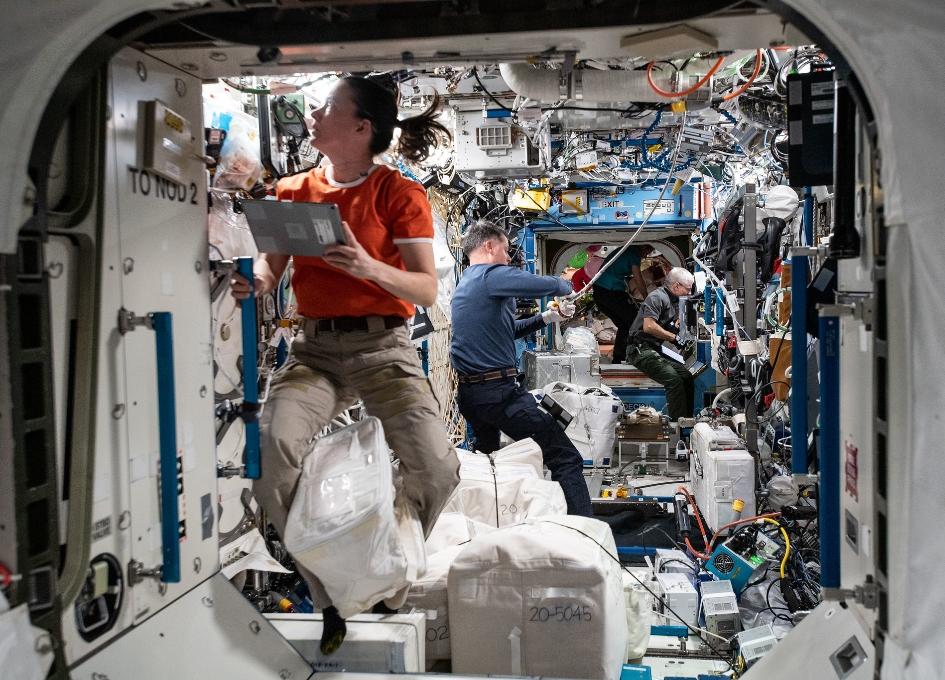
By cuterose
NASA Space Station On-Orbit Status 24 September, 2021 - Microbe Sampling
Rodent research, microbe sampling and Dragon packing filled the Expedition 65 crew's day at the end of the week aboard the International Space Station.
Three orbital residents are also preparing their Soyuz crew ship to switch docking ports next week.
NASA Flight Engineers Megan McArthur and Shane Kimbrough started their day observing mice once again inside the Life Science Glovebox (LSG) located in Japan's Kibo laboratory module. The space biology study is helping scientists identify genes and observe cell functions that are impacted by weightlessness and affect skin processes.
Assisting the duo, ESA (European Space Agency) Thomas Pesquet continued the mice observations during the afternoon. NASA Flight Engineer Mark Vande Hei handled the LSG set up and closeout operations during Friday's experiment work.
During the afternoon, McArthur swabbed and collected microbe samples from surfaces in the station's U.S. segment. She photographed the surface areas and stowed the samples for later analysis to document the types of microbes living on the orbiting lab.
Vande Hei and Commander Akihiko Hoshide of the Japan Aerospace Exploration (JAXA) spent a couple of hours on Friday loading the SpaceX Cargo Dragon resupply ship for return to Earth. The Cargo Dragon will undock from the Harmony module's forward international docking adapter on Thursday at 9:05 a.m. EDT. It will parachute to a splashdown off the coast of Florida several hours later for retrieval by SpaceX and NASA personnel.
Roscosmos cosmonauts Oleg Novitskiy and Pyotr Dubrov reviewed the procedures today and the path they will take when their Soyuz MS-18 spacecraft moves to a new port. Vande Hei will join his Russian crewmates when they undock from the Rassvet module at 8:21 a.m. on Tuesday. They will temporarily maneuver toward the station's U.S. segment where they will photograph the orbiting lab's configuration. Shortly after that, they will move back toward the Russian segment and redock to the Nauka multipurpose laboratory module at around 9 a.m.
The Russian segment's Zvezda service module fired its engines for less than a minute today slightly lowering the space station's orbit. The deorbit boost, as it is called, places the station at the correct phase ahead of the arrival of the Soyuz MS-19 crew ship and the departure of the Soyuz MS-18 crew ship in October.
On-Orbit Status Report
ISS Deboost - Today, the ISS performed a deboost using the SM main thrusters. The purpose of this boost is to set up the conditions for 2-orbit 65S Soyuz rendezvous and 64S Soyuz landing in October. The burn duration was 47 seconds with a Delta-V of 0.66 m/s.
Payloads:
BioMole:A crewmember Stowed the MinION Hardware that was used for the BioMole sampling.The Environmental Health System (EHS) Biomole Facility non-culture-based samples can provide microbial identification on-orbit within days of sampling.The goal of this Tech Demo is to conduct comparative analysis for possible replacement of current microbial monitoring systems.
Sally Ride Earth Knowledge Acquired by Middle Schools (EarthKAM):A crewmember performed a shutdown of the EarthKAM software and stowed the equipment. EarthKAM allows thousands of students to photograph and examine Earth from a space crew's perspective. Using the Internet, the students control a special digital camera mounted on-board the ISS. This enables them to photograph the Earth's coastlines, mountain ranges and other geographic items of interest from the unique vantage point of space. The EarthKAM team then posts these photographs on the Internet for viewing by the public and participating classrooms around the world.
Mochii: A crewmember removed and stowed the old Mochii Microscope.Mochii is a miniature scanning electron microscope (SEM) with spectroscopy to conduct real-time, on-site imaging and compositional measurements of particles on the ISS.Such particles can cause vehicle and equipment malfunctions and threaten crew health, but currently, samples must be returned to Earth for analysis, leaving crew and vehicle at risk. Mochii also provides a powerful new analysis platform to support novel microgravity science and engineering.
Pilote:A crewmember performed Wireless VR Headset troubleshooting as the unit is used for the PILOTE experiment.To test the ergonomics of a multisensory interface for controlling robotic arms and spacecraft, it is necessary to perform the trials in microgravity.Performing the test on Earth would lead to a design of a workstation using terrestrial ergonomic principles that do not correspond to conditions experienced on a spacecraft in orbit.The Pilote investigation tests the effectiveness of novel control schemes for the remote operation of robotic arms and space vehicles, using virtual reality and a new class of user-machine interfaces based on haptics.
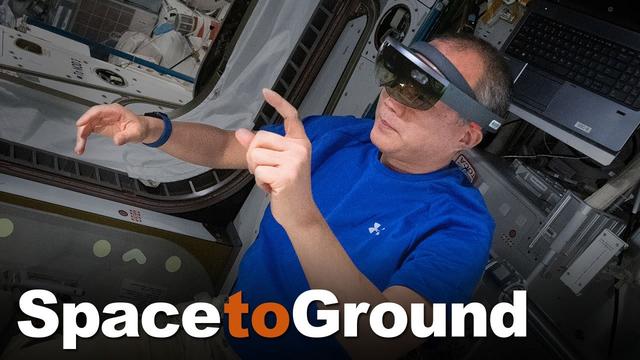
Rodent Research-Demonstration 1 (RR-D1): The crew performed Rodent Research Experiment 3 Day B operations. RR-D1 validates equipment and procedures for surgical techniques related to the wound healing process. Normal skin function and wound healing are important for maintaining good health, but spaceflight may impair healing of wounds in astronauts. Results from this investigation are intended to support design of a subsequent study on the effects of spaceflight on wound healing.
Thermal Amine System (TAS): The crew performed sampling of CO2 effluent from the Thermal Amine unit. Thermal Amine System tests a method to remove carbon dioxide (CO2) from air aboard the ISS, using actively heated and cooled amine beds. Controlling CO2 levels on the station reduces the likelihood of crew members experiencing symptoms of CO2 buildup, which include fatigue, headache, breathing difficulties, strained eyes, and itchy skin. The system includes elements that reduce loss of water vapor and recover CO2 for use in electrolysis to produce oxygen.
Systems:
Waste and Hygiene Compartment (WHC) In Flight Maintenance (IFM): As part of regularly scheduled preventative maintenance, the crew performed a manual WHC flush tank fill.By using a post-flight analysis bag to capture any pressure relief, also known as the burp, they depressurized the flush water tank and water valve block to protect the dose pump. This pump is critical as it injects the pre-treat required to properly recycle waste urine.
International Docking Adapter (IDA) Forward Multi-Layer Insulation (MLI) Reseat: The crew reattached the two corners of the IDA Forward MLI at the Z-ring location near the IMV duct strap. MLI is designed to protect equipment from MMOD and thermal damage.
Cargo Dragon Cargo Operations: The crew continued to perform cargo transfer operations for Cargo Dragon SpaceX-23 (SpX-23). SpX-23 undock is scheduled for September 30th to return cargo and payloads to the ground.
Completed Task List Activities:
NoneToday's Ground Activities:All activities are complete unless otherwise noted.
Attitude Control System (ACS) Optimized Propellant Maneuver (OPM) ExecutionConfigure ISS for ACS ISS DeboostAtmosphere Revitalization System (ARS) Thermal Amine Scrubber (TAS) mode changeLook Ahead Plan
Saturday, September 25 (GMT 268)Payloads:
NanoRacks Module-9 Ops 4 (NASA)Standard Measures Saliva setup (NASA)Systems:
Crew off-dutySunday, September 26 (GMT 269)Payloads:
RR-D1 Crew Review (NASA)Ring Shear Drop Sample Removal (NASA)Standard Measures Saliva collect (NASA)Systems:
Extravehicular Activity (EVA) Airlock UnstowWaste System InspectMonday, September 27 (GMT 270)Payloads:
RR-D1 3C Dissect, Controller stow (NASA)MERLIN-4 Dragon Uninstall (NASA)ICU Cubes Exchange (ESA)HRF VEG POMS Questionnaire (NASA)BioCulture System Hardware removal and Transfer (NASA)CIR Manifold 4 bottle change (NASA)Ring Shear Drop removal and install (NASA)NanoRacks Mainframe-A removal (NASA)Faraday Facility Removal (NASA)Standard Measures Saliva collect (NASA)Systems:
IFM EBOT Charger removalDragon cargo opsEVA battery removalPolar/Dragon transferToday's Planned Activities:All activities are complete unless otherwise noted.
Standard Measures Post-Sleep QuestionnaireNode 2 Drag Through Video SetupRodent Research Experiment 3 Day BWireless VR Headset troubleshooting performanceWireless VR Headset troubleshooting data transferISS HAM Columbus Pass KenwoodSwap out SSC6 with a new LaptopEarthKAM Node 2 Shutdown, Disconnect and StowAtmosphere Revitalization System (ARS) Thermal Amine Scrubber (TAS) SamplePolar Desiccant Swap in CygnusBioMole MinION StowMicrobial Tracking-3 Environmental Sample CollectionNode 2 Deck 2 Stowage ReplaceInternational Docking Adapter Forward Multi-Layer Insulation ReseatPublic Affairs Office (PAO) Event in High Definition (HD) in ColumbusWaste and Hygiene Compartment (WHC) Manual Fill InitiationEXPRESS Rack 6 Laptop Hard Drive SwapMicrobial Tracking-3 Sample Iceberg InsertWaste and Hygiene Compartment (WHC) Manual Fill TerminationCargo Transfer to DragonMSL Hardware TrashIn Flight Maintenance (IFM) Thermal Amine Scrubber (TAS) T49 Retrieval [aborted]Mochii Hardware DisassemblyLSG Secondary Crew Restraint Fold
Please follow SpaceRef on Twitter and Like us on Facebook.



